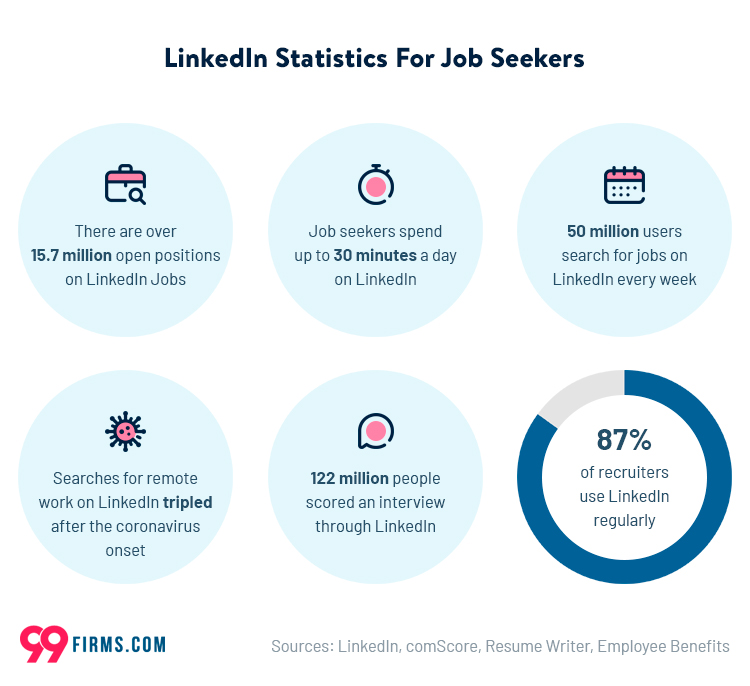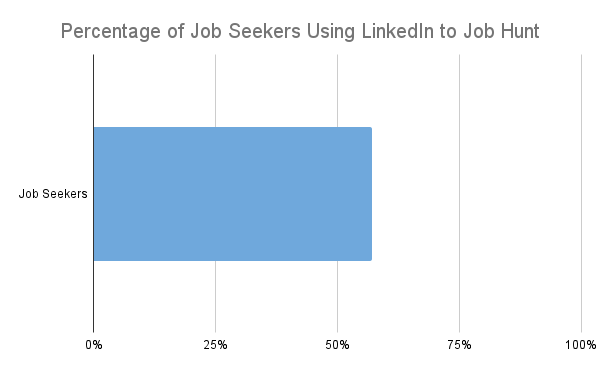Welcome to the world of LinkedIn job postings! It's an exciting digital marketplace where job seekers and employers come together. With millions of professionals navigating the platform daily, understanding how job postings work can significantly enhance your hiring or job search experience. Whether you're a recruiter seeking top talent or a candidate exploring new opportunities, knowing how to interpret LinkedIn job postings is essential. In this post, we'll delve into key aspects, starting with an overview of
What Does the Number of Applicants Indicate?

Have you ever noticed the number of applicants for a job posting on LinkedIn? That little figure can say a lot—more than just how many people clicked the "apply" button! Here are several insights into what that number really indicates:
- Popularity of the Job Posting: A high number of applicants usually means that the job posting resonates with many people. It could be due to the company's reputation, the role's appeal, or other attractive factors such as salary and benefits.
- Industry Demand: Certain fields are simply more competitive than others. If you're seeing hundreds of applicants for a tech role, it’s likely because the demand for tech talent is exceptionally high right now.
- Clarity and Reach: Clear, concise job descriptions that effectively communicate the requirements and benefits tend to attract more applicants. Additionally, the reach of the posting can influence applicant numbers—if it's posted in a well-trafficked group or shared broadly, expect those numbers to climb!
- Time Sensitivity: If a job posting has been up for a long time, the applicant count may reflect that. A fresh posting could lead to fewer applicants initially, but this number can soar within the first few days as job seekers share and apply.
But, remember, while a high applicant number sounds promising for employers, it doesn't always translate into the right candidates. You'll often need to sift through many applications to find the ones that truly fit the role.
For job seekers, understanding the context behind applicant numbers can also be beneficial. If you're applying for heavily-contested roles, you might want to highlight your unique skills or experiences more prominently to stand out.
In conclusion, the number of applicants on LinkedIn job postings offers valuable insights for both sides of the hiring process. By considering the underlying factors contributing to these numbers, you can make more informed decisions, whether you are hiring or seeking employment. Keep these points in mind as you navigate your LinkedIn journey!
Also Read This: Why Is LinkedIn Premium So Expensive? A Look at Its Features and Value
3. Factors Influencing the Number of Applicants

When you see the number of applicants for a job posting on LinkedIn, it’s crucial to understand that this number isn't just a random figure. Several factors influence how many candidates throw their hats in the ring. Let’s dive into some of the key elements that can sway applicant numbers:
- Job Title & Description: The attractiveness and clarity of the job title and description can significantly impact how many people apply. A well-crafted job description that highlights the role's responsibilities, required skills, and company culture will likely attract more applicants.
- Company Reputation: Companies with strong employer branding and positive reviews on platforms like Glassdoor often see higher application rates. If candidates feel good about a company's values and workplace culture, they’ll be more inclined to apply.
- Salary and Benefits: Transparent information about compensation and benefits can affect the number of applicants. Competitive salaries will naturally attract more talent, while vague or lower-than-average pay can deter potential candidates.
- Location: The job's geographical location plays a crucial role—remote opportunities tend to attract more applicants than those tied to a specific onsite location, especially if it’s in a less desirable area.
- Industry Demand: The industry's overall health can influence applicant numbers. High-demand fields like tech or healthcare usually attract more candidates than those in struggling sectors.
- Use of Keywords: Job postings that utilize relevant industry keywords are more searchable on LinkedIn. The more visible the posting, the higher the likelihood of attracting applicants.
- Application Ease: A simple and straightforward application process can significantly increase the number of applicants. If the application is cumbersome or lengthy, potential candidates may abandon it.
Understanding these factors can provide insightful context regarding applicant numbers. This knowledge can help both hiring managers and job seekers get a clearer picture of the competition and the job market dynamics.
Also Read This: How to Add Hashtags to Your LinkedIn Profile for Better Reach
4. How to Interpret Applicant Numbers for Job Seekers

For job seekers, the number of applicants on LinkedIn job postings can be both enlightening and intimidating. While a high applicant count might suggest fierce competition, it doesn't tell the whole story. Here are some guidelines on how to interpret these numbers effectively:
- Assess Competitiveness: If a job has hundreds of applicants, it's likely competitive. However, don’t let that dissuade you! If you meet the qualifications and can present your unique skills and experiences effectively, you still have a strong chance.
- Consider the Quality of Applicants: A high number of applicants isn’t always indicative of high-quality candidates. Often, many applicants apply out of curiosity or because they don’t meet the qualifications. Focus on how well you mirror the skills required.
- Look for Patterns: If you're applying for multiple jobs in the same industry, take note of how many applicants different postings attract. It can give you a sense of where the demand lies and help you tailor your applications accordingly.
- Timing Matters: The timing of your application can heavily influence your chances. The sooner you apply after a job is posted, the higher the likelihood that your application will be seen, even among many applicants.
- Don’t Let Numbers Deter You: While a high applicant count might make you feel less confident, remember that every job posting has its own unique situation. Trust in your skills and don’t shy away from applying just because of numbers.
Ultimately, knowing how to interpret applicant numbers can empower you as a job seeker. Instead of viewing these figures with anxiety, use them as a tool to position yourself better in your job search journey.
Also Read This: Is LinkedIn Premium Worth It in 2024
5. Insights for Employers: Leveraging Applicant Data
When it comes to managing job postings on LinkedIn, understanding applicant data can be a game changer for employers. This data not only provides insights into the effectiveness of your recruitment strategies but also helps you refine your approach to attract more qualified candidates.
First and foremost, analyzing applicant demographics is crucial. Take a closer look at the backgrounds of the candidates applying for your roles. Are they primarily from a specific industry, region, or skill set? This can reveal whether your job description is resonating with the right audience. For instance, if you notice a high number of applicants from a particular field, you might want to tailor your job listing slightly to align more with that sector’s jargon or expectations.
Another valuable insight is the applicant source. LinkedIn allows employers to see where their applications are coming from. This data can help you determine which channels are bringing in the most qualified candidates. For example, if you're finding that candidates from LinkedIn groups or sponsored posts are more suitable than those from general job boards, you might want to invest more resources into those specific areas.
Moreover, tracking the time-to-apply metric can yield useful insights. If you notice that it takes too long for candidates to submit applications, it may indicate that your application process is overly complicated. Simplifying the application process can significantly increase the number of applicants and potentially improve the quality.
Feedback loops are also essential. After the hiring process, consider reaching out to candidates (successful or otherwise) to gather feedback on their experience. Understanding what attracted them to your posting—or what deterred them—can inform your future job advertisements.
Lastly, leveraging data analytics tools can help you visualize these insights better. Using visual aids like graphs and charts can not only assist in understanding trends over time but also facilitate conversations within your hiring team. Don't overlook the power of data in shaping your recruitment processes; the more informed you are, the better you can adapt and succeed in attracting top talent.
Also Read This: How to Find Recruiters on LinkedIn Effectively
6. Common Misconceptions About Applicant Numbers
When it comes to the number of applicants on LinkedIn job postings, plenty of myths abound. Let’s clear the air about some common misconceptions that can mislead employers and job seekers alike.
- More Applicants = Better Quality Candidates: One of the biggest misunderstandings is that a high number of applicants guarantees quality. In reality, the quantity doesn’t always correlate with quality. A focused job post may attract fewer candidates but yield more relevant applications.
- All Applicants Are Actively Seeking Work: Many applicants on LinkedIn may not be actively looking for a job. They could be browsing or open to opportunities but are not seriously considering a transition. This nuance can skew perceptions about how urgently you need to fill a position.
- A High Volume of Applicants Means Interest in Your Company: Just because your job posting attracts many candidates doesn’t necessarily mean there’s significant interest in your company as a whole. Sometimes, it only indicates a weak job description or that the role is overly generic!
- Applicant Numbers Are Static: Recruiters might think that the number of applicants will remain the same throughout the job posting duration. But it's fluid; you may see spikes or drops based on factors like industry trends, economic shifts, or even the time of year.
- Every Application Should Be Reviewed: Another misconception is that all applications should receive equal attention. While every application deserves a fair chance, investing your time reviewing lower-quality candidates can be a misallocation of resources.
Recognizing these misconceptions can help employers approach their hiring process with a more informed perspective. By understanding that applicant numbers don’t tell the full story, you can better strategize on how to attract and identify the right candidates for your organization.
Also Read This: How to Message Recruiters to Connect on LinkedIn: Networking Tips for Job Seekers
7. Best Practices for Job Listings on LinkedIn
Creating effective job listings on LinkedIn is crucial for attracting the right talent. Here are some best practices to help ensure your job postings stand out:
- Craft a Catchy Job Title: The job title should accurately reflect the role while being engaging. Avoid jargon and make sure it’s easy to understand. For example, instead of “Synergistic Business Ninja,” use “Business Development Manager.”
- Write a Compelling Job Description: Start with an overview of your company culture and the role. Highlight the key responsibilities, required qualifications, and any exciting projects the new hire will be involved in. Use bullet points for clarity and readability.
- Be Transparent About Salary: Where possible, include salary ranges in the job listing. This transparency can save time and help attract candidates who are comfortable with the compensation offered.
- Highlight Company Benefits: Candidates want to know what’s in it for them! List benefits and perks such as flexible working hours, health insurance, career development opportunities, and any unique company cultures.
- Use Keywords Wisely: Incorporate relevant keywords that potential candidates might search for. This helps your listing appear in search results and ensures that the right audience finds your job posting.
- Include Company Values: Share your company’s mission and values. This can resonate with candidates who share similar principles and help you attract individuals who are a good cultural fit.
- Regularly Update Job Postings: If a job listing has been open for a while, consider refreshing the content. Add new insights or updates about the position or the company to maintain interest.
By applying these best practices, you can significantly increase the effectiveness of your job listings on LinkedIn, drawing in quality applicants that align with your organizational needs.
8. Conclusion and Key Takeaways
Understanding the number of applicants on LinkedIn job postings is essential for both job seekers and employers. It provides valuable insights into the competitive landscape and can influence hiring strategies. Here are some key takeaways to remember:
- Volume of Applicants Can Vary: The number of applicants can differ based on industry, job function, and location. Being aware of these variances can help set realistic expectations.
- Quality Over Quantity: While a high number of applicants may seem appealing, it’s the quality of those applications that matter. Focus on crafting job postings that attract the right candidates rather than just aiming for a large pool.
- Active Engagement is Key: Employers should actively engage with potential candidates, whether it’s through messaging, following up on applications, or participating in LinkedIn groups relevant to the position. This can enhance the hiring process.
- Continuous Learning is Essential: The job market is always changing. Keep an eye on trends and adjust your recruiting strategies accordingly to stay competitive.
- Utilize LinkedIn Features: Use LinkedIn's tools, such as LinkedIn Recruiter and job posting analytics, to enhance your recruitment efforts and understand applicant behaviors better.
In conclusion, leveraging LinkedIn for job postings involves more than just hitting "publish." By understanding the dynamics of the job market and following best practices, employers can optimize their efforts and create more effective job postings that resonate with top talent.
 admin
admin








